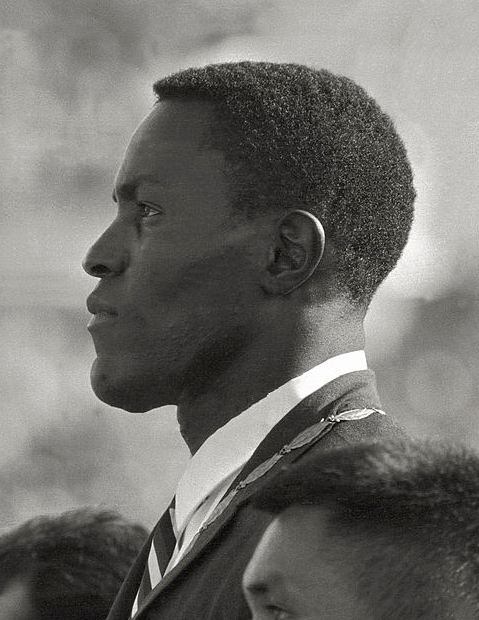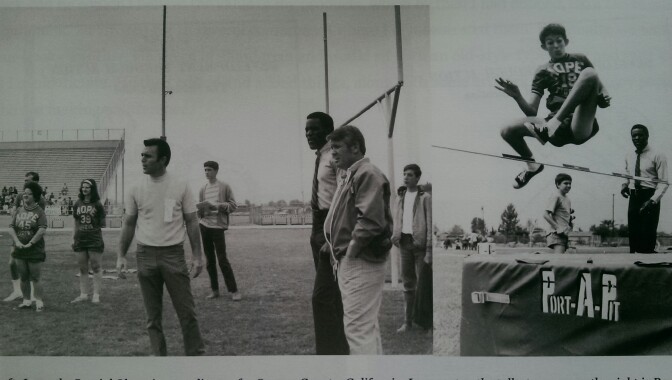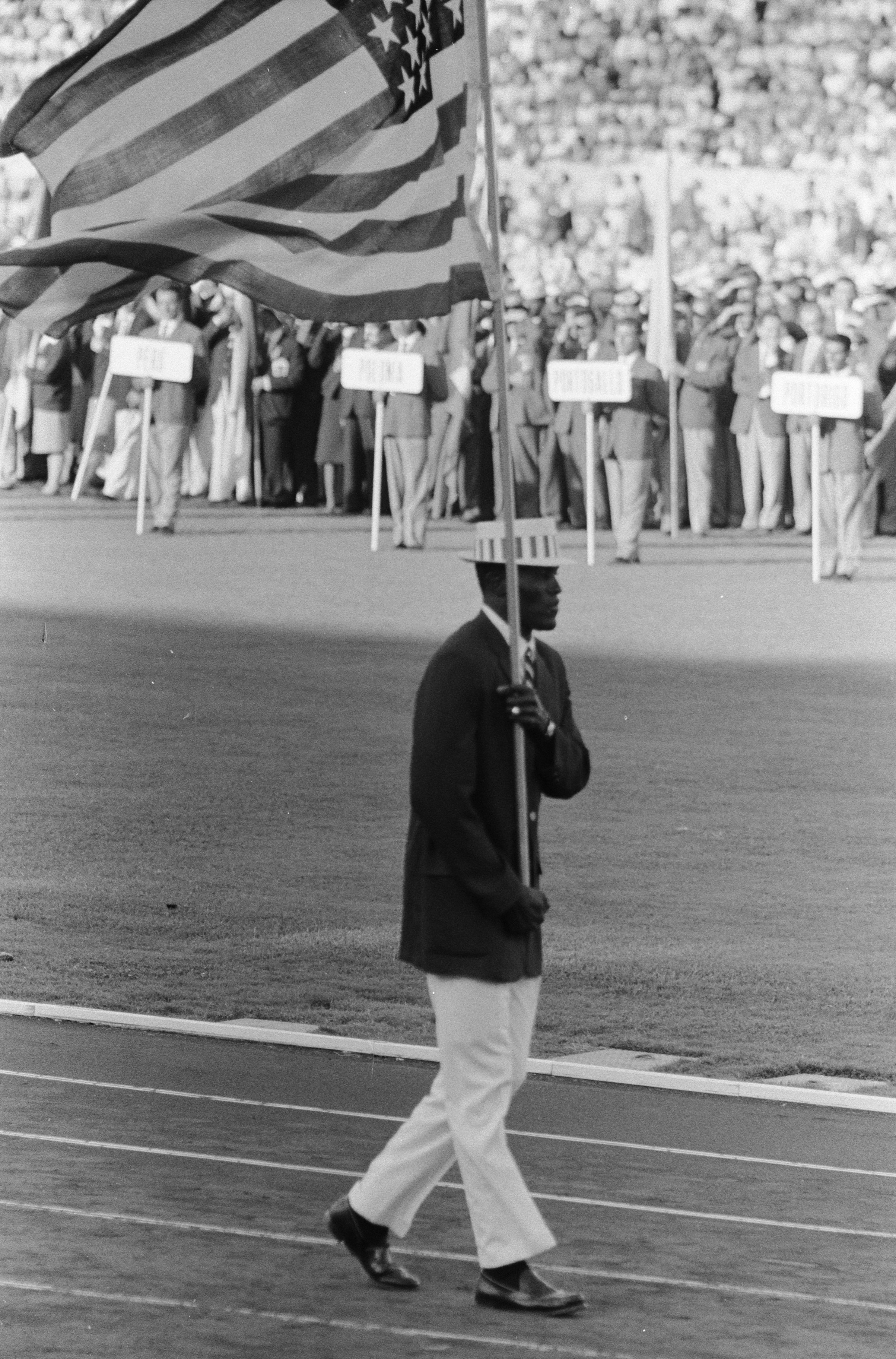1. Early Life and Education
Rafer Johnson's early life was marked by his family's relocation and his emergence as a multi-talented athlete.
1.1. Childhood and Family Background
Rafer Lewis Johnson was born on August 18, 1934, in Hillsboro, Texas. When he was nine years old, his family relocated to Kingsburg, California. For several years, Johnson's family was the only African American family in the entire town of Kingsburg. This early experience in a racially homogeneous environment was a notable aspect of his formative years.
1.2. High School and Collegiate Athletics
Johnson was a versatile athlete during his time at Kingsburg High School, playing on the soccer, baseball, and basketball teams. His leadership qualities were also evident, as he was elected class president in both junior high and high school. At the age of 16, between his sophomore and junior years of high school, his coach, Murl Dodson, drove him to Tulare, California, to watch Bob Mathias compete in the 1952 U.S. Olympic decathlon trials, sparking Johnson's interest in the decathlon. Inspired, Johnson reportedly told his coach that he "could have beaten most of those guys." Weeks later, he competed in a high school invitational decathlon and won the event. He continued his success by winning the California state high school decathlon meets in both 1953 and 1954.
In 1954, Johnson enrolled at the University of California, Los Angeles (UCLA). As a freshman, his progress in the decathlon was remarkably rapid; he broke the world record in only his fourth competition. He was also a member of the Pi Lambda Phi fraternity, which was notable as America's first non-sectarian fraternity, and served as class president at UCLA. Beyond track and field, Johnson also played basketball for the UCLA Bruins under the legendary coach John Wooden. He was a starter for the team during their 1958-59 season. Coach Wooden highly regarded Johnson as a defensive player, though he sometimes expressed regret for not having utilized Johnson more in offensive fast breaks during his early coaching career.
Johnson's athletic talent extended to other sports, as he was selected by the Los Angeles Rams in the 28th round (333rd overall) of the 1959 NFL draft as a running back. He was also chosen as a guard by the Los Angeles Jets as one of their two territorial selections in the inaugural 1961 ABL draft. Despite these selections, Johnson never played professionally for either team or in either league, choosing to focus on his Olympic aspirations.
2. Athletic Career
Rafer Johnson's athletic career is defined by his dominance in the decathlon, culminating in an Olympic gold medal.
2.1. Early Success and World Records
Johnson's impressive rise in the decathlon began shortly after he started attending UCLA. In 1955, he achieved his first major international victory by winning the decathlon gold medal at the 1955 Pan American Games in Mexico City. This triumph came after he had already broken the world record in his fourth decathlon competition earlier that year. His exceptional skill and consistency were further demonstrated by setting new world records in 1958 and again in 1960, solidifying his status as a top contender in the sport.
2.2. Olympic Games
Johnson's Olympic journey included two memorable appearances, each highlighting his resilience and competitive spirit.
2.2.1. 1956 Melbourne Olympics
Rafer Johnson qualified for both the decathlon and the long jump events at the 1956 Summer Olympics in Melbourne, Australia. However, a hamstring injury significantly hampered his performance, forcing him to withdraw from the long jump competition. Despite this setback and competing with a physical limitation, Johnson displayed immense determination, securing a silver medal in the decathlon. This marked his only defeat in the decathlon event throughout his entire athletic career, underscoring his consistent excellence.
2.2.2. 1960 Rome Olympics
The pinnacle of Rafer Johnson's athletic career arrived at the 1960 Summer Olympics in Rome, Italy. He was honored with the role of the U.S. team's flag bearer during the opening ceremonies, a significant recognition for his athletic stature and leadership. The decathlon competition at these Games became a legendary contest due to his intense rivalry with Yang Chuan-Kwang (C.K. Yang) from Taiwan. Yang was not only a formidable competitor but also Johnson's friend and UCLA teammate, with both athletes training under UCLA track coach Elvin C. "Ducky" Drake.
Throughout the decathlon's ten events, the lead swung back and forth between Johnson and Yang. After nine events, Johnson held a narrow lead, but Yang was known to be superior in the final event, the 1500 m run. According to legend, Coach Drake, who had coached both men, gave them specific advice: he told Johnson to stay close to Yang and prepare for a "hellish sprint" at the end, while advising Yang to create as much distance as possible from Johnson before the final sprint.
In the grueling 1500 m race, Johnson ran his personal best, finishing only 1.2 seconds slower than Yang. This close finish allowed Johnson to clinch the gold medal by a margin of 58 points, setting a new Olympic record with a total of 8,392 points. The two exhausted athletes leaned against each other for support just beyond the finish line, a testament to their mutual respect and the intensity of their competition. With this triumphant victory, Rafer Johnson concluded his illustrious athletic career.
The table below summarizes Rafer Johnson's major achievements in the decathlon:
| Year | Competition | Location | Event | Result | Score |
|---|---|---|---|---|---|
| 1955 | Pan American Games | Mexico City (Mexico) | Decathlon | Gold | 6994 points |
| 1956 | Olympics | Melbourne (Australia) | Decathlon | Silver | 7587 points |
| 1960 | Olympics | Rome (Italy) | Decathlon | Gold | 8392 points |
Johnson's personal bests for individual events in the decathlon include:
- 100 m - 10.3 (1957)
- 220 yd - 21.0 (1956)
- 400 m - 47.9 (1956)
- 110 mH - 13.8 (1956)
- High Jump - 6.2 ft (1.89 m) (1955)
- Pole Vault - 13 ft (4.09 m) (1960)
- Long Jump - 25 ft (7.76 m) (1956)
- Shot Put - 55 ft (16.75 m) (1958)
- Discus Throw - 172 ft (52.5 m) (1960)
- Javelin Throw - 252 ft (76.73 m) (1960)
- Decathlon - 8392 (1960)

3. Post-Athletic Career
After retiring from competitive athletics, Rafer Johnson embarked on diverse careers in entertainment and public service, notably dedicating himself to social activism.
3.1. Acting and Broadcasting
Following his retirement from athletics, Johnson transitioned into a career in entertainment. He began acting in motion pictures and working as a sportscaster in 1960. While still training for the 1960 Olympics, his friend Kirk Douglas offered him the role of Draba, the Ethiopian gladiator, in the film Spartacus. Douglas believed the role could make Johnson a star, but Johnson was forced to decline it because the Amateur Athletic Union deemed that accepting it would classify him as a professional athlete, thereby making him ineligible for the Olympics under the rules at the time. The role was eventually taken by another UCLA alumnus, Woody Strode.
Johnson made several film appearances, predominantly in the 1960s, including roles in The Sins of Rachel Cade (1961), the Elvis Presley film Wild in the Country (1961), Pirates of Tortuga (1961), None but the Brave (1965), and two Tarzan films alongside Mike Henry: Tarzan and the Great River (1967) and Tarzan and the Jungle Boy (1968). He also appeared in The Last Grenade (1970), Soul Soldier (1970), The Games (1970), Mission: Impossible (1971), Roots: The Next Generations (1979), the James Bond film Licence to Kill (1989) as Mullens, and Think Big (1990). Johnson also played Kosongo in The Sins of Rachel Cade (1960) and had an uncredited role in Sergeant Rutledge (1960). His television credits included The Alfred Hitchcock Hour (1963) and Daniel Boone (1965). In addition to acting, Johnson worked full-time as a sportscaster in the early 1970s, serving as a weekend sports anchor for the local NBC affiliate in Los Angeles, KNBC. Although he appeared uncomfortable in this position, he eventually moved on to other endeavors. He also served as a technical advisor for the 1965 film Billie and was an associate producer for The Black Six (1973).
3.2. Public Service and Social Activism
Johnson's commitment to public service and humanitarian efforts was a significant part of his life, with his work notably impacting social causes and supporting vulnerable populations.
3.2.1. Involvement in Robert F. Kennedy's Campaign
Rafer Johnson became actively involved in the presidential election campaign of United States Senator Robert F. Kennedy. On June 5, 1968, a tragic event unfolded when Robert F. Kennedy was fatally shot at the Ambassador Hotel in Los Angeles, California. In the immediate aftermath of the assassination, Johnson, along with football player Rosey Grier and journalist George Plimpton, bravely helped to apprehend the assassin, Sirhan Sirhan. Kennedy succumbed to his injuries the following day at Good Samaritan Hospital. Johnson later recounted this harrowing experience in his autobiography, The Best That I Can Be, which was published in 1999 and co-authored with Philip Goldberg. This critical intervention highlighted Johnson's courage and commitment to public safety during a moment of national crisis.
3.2.2. Special Olympics Activities
Johnson played an instrumental role in the establishment and growth of the Special Olympics, demonstrating his profound dedication to individuals with intellectual disabilities. His involvement began in 1968, when he served on the organizing committee for the first Special Olympics competition in Chicago, an event hosted by Special Olympics founder, Eunice Kennedy Shriver. The following year, in 1969, Johnson spearheaded the founding of the California Special Olympics. Alongside a small group of dedicated volunteers, he organized the first California Games at the Los Angeles Memorial Coliseum, which brought together 900 individuals with intellectual disabilities to compete.
After the inaugural California Games, Johnson became one of the original members of the board of directors for the California Special Olympics. This board worked diligently to raise funds and establish a modest program featuring swimming and track and field events. His commitment deepened in 1983 when he ran for President of the Board, aiming to increase board participation, optimize staff talents, and expand fundraising efforts. Johnson was elected president and served in this capacity until 1992, at which point he was appointed chairman of the Board of Governors. His leadership and unwavering dedication were crucial in transforming the California Special Olympics into a thriving organization, providing countless opportunities for athletes with intellectual disabilities.

4. Personal Life
Rafer Johnson married Elizabeth Thorsen in 1971. The couple had two children, daughter Jennifer and son Joshua, and were grandparents to four grandchildren.
His family also includes notable figures in the sports world. His brother, Jimmy Johnson, is a highly respected member of the Pro Football Hall of Fame. His daughter, Jennifer Johnson Jordan, followed in his athletic footsteps, competing in beach volleyball at the 2000 Summer Olympics in Sydney after a successful collegiate career at UCLA. His son, Joshua Johnson, also pursued track and field, achieving a podium finish in the javelin throw at the USA Outdoor Track and Field Championships. Johnson himself was also involved in the Art of the Olympians program, which celebrates the artistic talents of Olympians and Paralympians.
5. Death
Rafer Johnson passed away on December 2, 2020, at the age of 86. He died in Sherman Oaks, California, after suffering a stroke.
6. Legacy and Honors
Rafer Johnson's legacy is marked by an extensive array of awards, recognitions, and tributes that celebrate his extraordinary athletic achievements and profound humanitarian contributions.
6.1. Major Awards and Recognition
Throughout his life, Rafer Johnson received numerous prestigious awards acknowledging his excellence in sports and his impact on society:
- In 1958, he was named Sports Illustrated's Sportsman of the Year, a testament to his athletic dominance.
- In 1960, he was awarded the James E. Sullivan Award as the top amateur athlete in the United States, notably breaking the award's color barrier by becoming the first Black recipient.
- In 1962, he received the Golden Plate Award from the American Academy of Achievement.
- During the opening ceremonies of the 1984 Summer Olympics in Los Angeles, Johnson was chosen to ignite the Olympic Flame, a deeply symbolic moment as he became the first Black athlete in Olympic history to do so.
- He was inducted into the inaugural class of the World Sports Humanitarian Hall of Fame in 1994.
- In 1998, ESPN recognized him as one of the 100 Greatest North American Athletes of the 20th Century.
- The NCAA named him one of the 100 Most Influential Student Athletes of the past 100 years in 2006.
- On December 1, 2009, he was inducted into the California Hall of Fame by Governor Arnold Schwarzenegger and Maria Shriver at The California Museum in Sacramento.
- Johnson was also a member of The Pigskin Club of Washington, D.C. National Intercollegiate All-American Football Players Honor Roll.
- In 2010, he received the Fernando Award for Civic Accomplishment from the Fernando Foundation.
- He was inducted into the Bakersfield City School District Hall of Fame in 2011.
- In November 2014, Johnson was honored with the Athletes in Excellence Award from The Foundation for Global Sports Development, in recognition of his extensive community service efforts and work with youth.
- In 2016, he was inducted into the Texas Track and Field Coaches Hall of Fame.
- In 2005, Whittier College awarded Johnson an honorary Doctor of Humane Letters (L.H.D.) degree.

6.2. Memorials and Tributes
Rafer Johnson's lasting influence is recognized through various memorials and tributes:
- Rafer Johnson Junior High School in Kingsburg, California, is named in his honor, reflecting his roots in the community.
- In Bakersfield, California, both the Rafer Johnson Community Day School and the Rafer Johnson Children's Center bear his name. The Children's Center, which provides classes for special education students from birth to five years old, hosts an annual "Rafer Johnson Day." Johnson consistently attended this event, speaking to and cheering on hundreds of students with special needs as they participated in various track and field events, highlighting his enduring connection to the community and his dedication to Special Olympics.
- Johnson served as the athletic advisor to Dan Guerrero, the Director of Athletics at UCLA, demonstrating his continued commitment to his alma mater and collegiate sports.
- Each year in mid-April, UCLA hosts the Rafer Johnson-Jackie Joyner-Kersee Invitational, a three-day track and field festival, which commemorates his and fellow Olympian Jackie Joyner-Kersee's contributions to the sport.